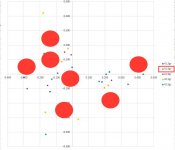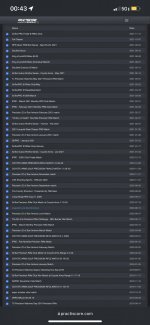Well, here's what I got today. I've got some more work I'd like to do and I'll see if I can get the Excel sheet uploaded here-- if nothing else I'll try to get it in a google doc or something.
Each dot represents a 5 round group MPOI (Scale is inches at 200yd). Each color represents a charge weight. I will be further breaking these into subsets of 1st, 2nd, 3rd, 4th, 5th, and 6th group of each charge weight. I'm about half way through that and I'll spoil it for you-- they don't repeat. These are less messy to look at, too.
This data set has the most resolution, but the gun was moved between some of the sets, so each set of 35 is referenced off of its own MPOI. Some 'global' position could be lost, but in my experience with other powder ladders, even over 3-4gr spreads the MPOI of the large data sets is within about a .08 MOA window in the worst cases.
Nevertheless, if you look at this below, you'll see 5 shot group MPOI of the same ammo varies in a .35ish MOA window... so even if my 'global' 35 shot group is .04 or .06 or .08 MOA in error, it's completely swallowed up by the randomness of 5 shot samples-- which has been my point all along. There are not many viable conclusions to draw from 5-shot groups, and the difference in dispersion performance or MPOI between two varied powder charges is not among them. These patterns repeat over and over. Noisy data until 15-30 rounds in... It's the same thing you learn in probability and statistics, it's the same rule of thumbs that every statistical process control/analysis people use... Somehow people think shooting is different I guess?

Sorry if I'm short, but I've had this play out already. I started with shoulder fired rifles & contoured barrels with me aiming them and had people claim I wasn't steady enough to have valid data. I switched to an accuracy fixture and 1.25" barrels and get told that it's too rigid to show OCW results. My data came to the same conclusion both ways... I've burned out barrels doing this and have people tell me I'm wrong with no supporting data, or refute large sample data with more small sample data. It gets old.
Each dot represents a 5 round group MPOI (Scale is inches at 200yd). Each color represents a charge weight. I will be further breaking these into subsets of 1st, 2nd, 3rd, 4th, 5th, and 6th group of each charge weight. I'm about half way through that and I'll spoil it for you-- they don't repeat. These are less messy to look at, too.
This data set has the most resolution, but the gun was moved between some of the sets, so each set of 35 is referenced off of its own MPOI. Some 'global' position could be lost, but in my experience with other powder ladders, even over 3-4gr spreads the MPOI of the large data sets is within about a .08 MOA window in the worst cases.
Nevertheless, if you look at this below, you'll see 5 shot group MPOI of the same ammo varies in a .35ish MOA window... so even if my 'global' 35 shot group is .04 or .06 or .08 MOA in error, it's completely swallowed up by the randomness of 5 shot samples-- which has been my point all along. There are not many viable conclusions to draw from 5-shot groups, and the difference in dispersion performance or MPOI between two varied powder charges is not among them. These patterns repeat over and over. Noisy data until 15-30 rounds in... It's the same thing you learn in probability and statistics, it's the same rule of thumbs that every statistical process control/analysis people use... Somehow people think shooting is different I guess?
Sorry if I'm short, but I've had this play out already. I started with shoulder fired rifles & contoured barrels with me aiming them and had people claim I wasn't steady enough to have valid data. I switched to an accuracy fixture and 1.25" barrels and get told that it's too rigid to show OCW results. My data came to the same conclusion both ways... I've burned out barrels doing this and have people tell me I'm wrong with no supporting data, or refute large sample data with more small sample data. It gets old.



